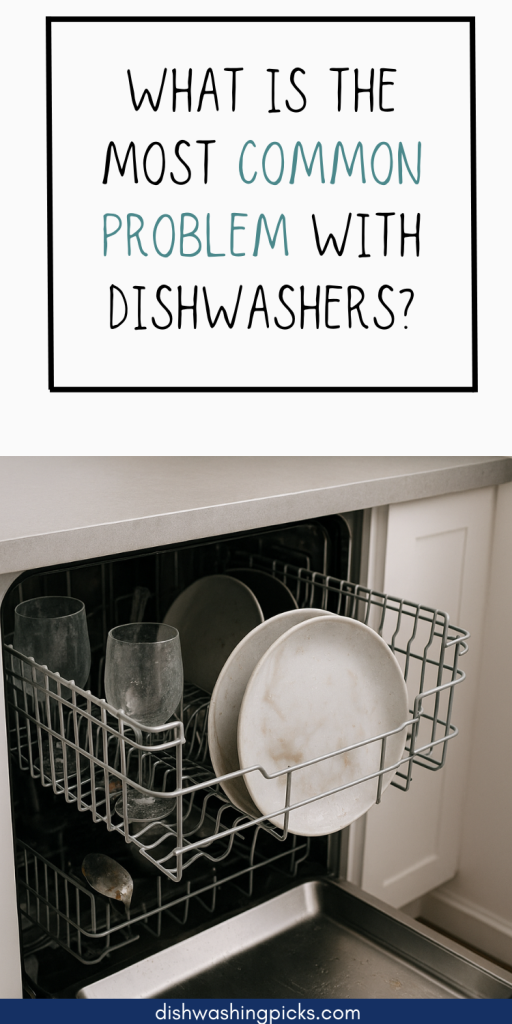
When Your Dishwasher Acts Up…
Ever pressed that magical start button and then… nothing? Or worse—heard some odd noises and opened it later to find dishes still dirty?
Yep, we’ve all been there.
Dishwashers are supposed to make life easier, not give us another headache. But sometimes, even the most reliable kitchen helpers start acting weird. So what’s really going on under the hood when things go sideways?
Let’s peel back the door (not literally—yet!) and figure out the most common issue people run into with dishwashers… and what to do about it.
→ Next up: the #1 culprit behind most dishwasher frustrations.
So… What’s the Most Common Problem?
Drumroll, please…
The most common problem with dishwashers is poor drainage.
That’s right. One of the top complaints is: “Why is there water sitting at the bottom of my dishwasher?”
It’s not just gross—it can also lead to musty smells, streaky dishes, and even mold if left unchecked.
But why does it happen?
Imagine this: Your dishwasher’s trying to drain the dirty water out, but something’s blocking the flow—like leftover food bits, grease, or even a rogue piece of broken glass. Over time, this buildup clogs the filter, drain hose, or pump. End result? A watery mess you didn’t sign up for.
Sound familiar?
Let’s dig into how you can spot this issue—and whether it’s a DIY fix or time to call in backup.
→ Coming up: signs your dishwasher isn’t draining properly (and what to do about it).
How to Tell If It’s a Drainage Problem
Here’s a quick mental checklist:
- Is there standing water after a full cycle?
- Does your dishwasher smell funky—even after a “clean” cycle?
- Hear weird gurgling sounds when it runs?
- Is your dishwasher unusually slow to finish?
If you’re nodding your head to any of those, drainage is probably your gremlin.
Try thinking of it this way: Your dishwasher is like a mini car wash. If the water can’t drain out properly, it’s like your car leaving the wash… covered in suds and soap. Not ideal.
Luckily, there are a few things you can check before panic-shopping for a new machine.
→ Next: simple fixes you can try yourself (no toolkit required).
Quick Fixes Before You Call a Pro
Before you even think about calling a technician, try these easy-peasy steps:
- Clean the filter
You’d be amazed how much gunk hides in there. Pop it out, rinse it with hot water, and scrub gently with a toothbrush if needed. - Check the drain hose
Kinked or clogged? Straighten it out and clear any obstructions. - Run a vinegar rinse
Pour a cup of white vinegar into the bottom of the machine and run it empty on hot. Helps dissolve grease and deodorizes, too. - Use dishwasher-safe cleaners
These help bust through hidden buildup in spray arms and jets.
Still stuck? Don’t worry—some problems do require a little extra help.
→ Next up: when it’s time to throw in the dish towel and call the pros.
When to Call for Help
If you’ve tried all the DIY tricks and you’re still seeing standing water—or worse, getting error codes—it might be time to call a technician.
Here are some signs it’s out of your hands:
- The drain pump is making weird noises or not running at all
- Water keeps backing up, even after cleaning
- Your dishwasher won’t even start a cycle
Pro tip: If your machine is under warranty, don’t tinker too much—you could void it. Just make the call and let the pros work their magic.
→ Wrapping up: final thoughts and a few takeaways to keep things running smooth.
Keep Your Dishwasher Happy
Here’s the deal: Most dishwasher issues start small—just like that tiny piece of spaghetti stuck in the filter.
The key? Pay attention to the signs, do some regular cleaning, and don’t ignore strange smells or standing water. A little care goes a long way.
So next time your dishwasher misbehaves, you won’t panic—you’ll know exactly what to look for.
And hey, if you’re reading this while staring at a puddle inside your machine… maybe give that filter a peek?
